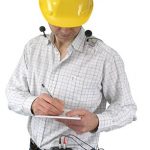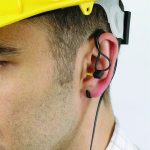SV 102+ Dual Channel Noise Dosimeter replaces our ground breaking SV 102. It has been designed for the accurate measurement of noise exposure to ISO 9612 and MIRE (microphone in real ear) measurements to ISO 11904-1.
This new instrument uses a class beating high resolution, full color OLED screen making it even easier to read; even in full daylight. The small memory capability of its predecessor; the SV102, has been upgraded by adding a microSD card for an incredible amount of storage capability. The sampling rate has been increased from 24 kHz to 48 kHz which enables the measurement of sound in the full frequency band. Also new is an LED that indicates the status of the measurement and changes color when the noise dose exceeds the limit set.
A unique feature of all SVANTEK dosimeters, including the SV102 +, is their ability to simultaneously analyze 1/1 octave and record audio events . The use of 1/1 octave analysis is the most accurate method for the correct selection of hearing protection to ISO 4869-2 while simultaneous audio recording allows the user to capture and eliminate false sounds affecting the result of exposure to noise.
Unlike classic single channel noise dosimeters, the two channel SV102 + gives the unique opportunity to assess the exposure on both sides of the head simultaneously. This is particularly important where a worker is exposed to noise coming from a dominant directional source where placing the microphone on only one side could understate the true level of noise exposure. Another use of dual channel technology is the simultaneous measurement of noise both outside and inside any hearing protection being used with the use of a SV25S MIRE microphone.
MIRE methodology requires 1/3 octave analysis, another feature uniquely available in the SV102 + . MIRE measurement involves measuring the sound in the ear and performing a one-third octave band analysis on it. Using the SV102 + in conjunction with a special microphone probe like the SV25S, placed at the entrance of the ear canal, makes this all possible . A typical application of MIRE measurement is noise exposure monitoring in telephone call centres where the sound comes from the headphones; an application not suited to classical dosimetry methods.
Calibration of the both the SV102 + and the MIRE microphone is done using a SV34 calibrator. The calibration factor is stored inside the instrument and in the TEDS memory of the SV102+ microphones. This cross checking solution helps to prevent incorrect calibration factors being used.
The SV102 + is a low power instrument and is powered using only two small AAA batteries. It is fully supported by our Supervisor software which is dedicated to Health and Safety applications.
Photos
Features
- Dual channel Acoustic Dosimeter conforming to IEC 61252 and ANSI S1.25-1991
- Dual channel class 2, Sound Level Meter conforming to IEC 61672
- Dual channel 1/1 octave analysis (option)
- Dual channel 1/3 octave analysis (option)
- Single measurement range
- Measurement range 45 dBA RMS ÷ 141 dBA Peak
- MIRE measurement technique with SV 25S (optional hadrware required)
- Individual evaluation of the HPDs attenuation in real-world
- Three parallel independent profiles per channel
- Advanced data logger with audio-events-recording (option)
- Automatic calibration thanks to the TEDS technology
- MicroSD card 8 GB
- USB interface
- Super contrast OLED display 160×128 pixels
- Integration time programmable up to 24 h
- Power supply by two AA rechargeable or standard batteries
- Easy operation
- Extremely compact, light weight (260 grams with batteries) and robust case (volume comparable to PDA devices)
Specification
SV 102+ Dual-Channel Acoustic Dosimeter Specification
Dosimeter/SLM/Analyser |
|
| Standards | IEC 61252; ANSI S1.25-1991; Class 2: IEC 61672:2002, ISO 11904-1 |
| Acoustic Dosimeter Mode | Lav/Leq, SPL, Lmax, Lmin, SEL, SEL8, PSEL, LEPd, Dose (%), TWA, E, E_8h, Peak, Run Time, Upper Limit Time (ULT), L(C-A), Projected Dose (D_8h) |
| SLM Mode | Leq, Spl, SEL, LEP,d, Lden, Ltm3, Ltm5, statistics – Ln (L1- L99), LMax, LMin, LPeak Simultaneous measurement in three profiles with independent set of filters and detectors |
| Weighting Filters | A, C and Z |
| RMS Detector | Digital true RMS detector with Peak detection, resolution 0.1 dB Time constants: Slow, Fast, Impulse |
| Microphone | SV 25D, Class 2, ceramic microphone, 1/2″ housing with built-in preamplifier & integrated cable SV 25S, special microphone with dedicated probe for Microphone-In-Real-Ear technique (option) SV 25D and SV 25S have built-in TEDS functionality for the automatic calibration |
| Measurement Range | 45 dBA RMS ÷ 141 dBA Peak (with SV 25D microphone) |
| Frequency Range | 20 Hz ÷ 20 kHz, sampling rate 48 kHz |
| Dynamic Range | 100 dB |
| Data Logger1 | Time-history logging of Leq/Lmax/Lmin/Peak/Lav results to internal memory with time step down to 100 millisecond to microSD card |
| Audio Recorder1 | Time-domain signal events recorder (option) |
| Dual-channel Mode | Dual-channel measurement mode with second microphone SV 25D or SV 25S |
| 1/1 Octave1 | Dual-channel 1/1 octave real-time analysis and spectra logging, 10 filters with centre frequencies from 31.5 Hz to 16 kHz, Type 1: IEC 61260 (option) |
| 1/3 Octave1 | Dual-channel 1/3 octave real-time analysis and spectra logging, 31 filters with centre frequencies from 20 Hz to 20 kHz, Type 1, IEC 61260 (option) |
Basic Data |
|
| Input | 2 x LEMO 2-pin, Direct |
| Display | Colour 160 x 128 pixels OLED type |
| Memory | MicroSD card 8 GB (removable & upgradeable) |
| Interfaces | USB 1.1 Client Extended I/O – AC output (1 V Peak) / Digital Output (Alarm trigger) / Digital Input (Input trigger) |
| Power Supply | Two AA batteries (alkaline): operation time > 16 h (3.0 V / 1.6 Ah)2 Two rechargeable batteries (not included): operation time > 20h (2.4 V / 2.6 Ah)2 USB interface: 150 mA HUB |
| Environmental Conditions | Temperature: from -10 oC to 50 oC Humidity: up to 90 % RH, non-condensed |
| Dimensions | 95 x 83 x 33 mm (without microphones) |
| Weight | 260 grams with batteries (without microphones) |
1function parallel to the acoustic dosimeter mode or meter mode
2depends on instrument operation mode
*Continuous product development and innovation are the policy of our company. Therefore, we reserve the right to change the specifications without prior notice.





